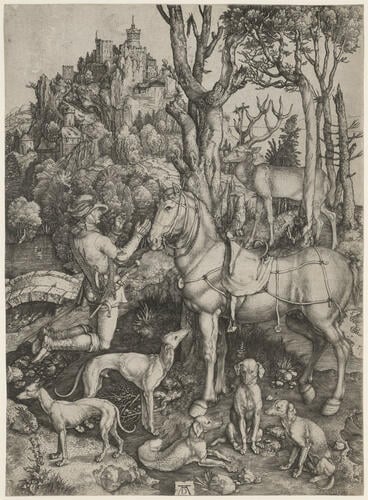-
1 of 253523 objects
Albrecht Dürer (1471-1528)
St Eustace c.1501
Engraving | 35.1 x 25.6 cm (sheet of paper) | RCIN 800067
-
An engraving showing St Eustace kneeling before a stag with a crucifix between its antlers.
St Eustace was a Roman general who encountered a large stag while out hunting. He pursued the beast but found, when it stopped, that it had an image of the crucified Christ between its antlers. The encounter led to Eustace’s conversion to Christianity. Eustace was one of the Fourteen Holy Helpers, a group of saints who were the subject of particular veneration in Germany and who were believed to assist in cases of illness and at the time of death. The legend of St Eustace was a popular subject in late medieval art. Dürer noted distributing the St Eustace engraving six times during his trip to the Netherlands in 1521, while aspects of the print were soon copied by other artists.
Dürer’s version of the legend represents a number of departures from his earlier engravings, notably in the large size of the plate and in the placing of his monogram on a fictive scrap of paper at bottom centre. The animals are carefully portrayed, and particularly notable is the variety of depiction of the five hunting dogs, which are carefully posed to show different aspects of the canine figure: standing to left, standing to right, seated, crouching and lying. A study for one of these, the standing dog which lifts its muzzle to Eustace’s horse, is also in the Royal Collection, and is the only surviving study for this print.
Catalogue entry adapted from The Northern Renaissance. Dürer to Holbein, London 2011Provenance
In the Royal Collection by c.1810
-
Creator(s)
(engraver) -
Medium and techniques
Engraving
Measurements
35.1 x 25.6 cm (sheet of paper)
Category
Object type(s)
